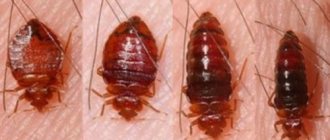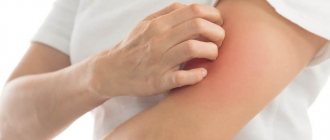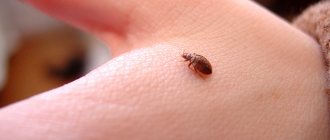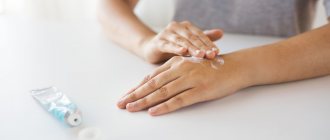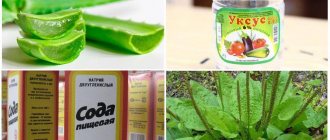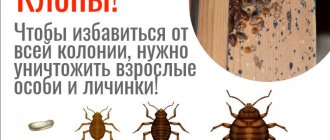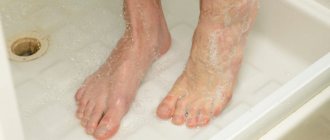What do bedbug bites look like on children's bodies?
As a rule, bed bugs are active at night and bite a child when he is fast asleep in his crib. Usually the bug bites 3 to 5 times, moving in a straight line. This feature is clearly visible in the photo. In appearance, the marks resemble mosquito bites, although they have some characteristic differences:
- bites on the baby’s body appear in the morning and are located along a trajectory resembling a path;
- droplets of blood remain on the child’s bed and pajamas, since bedbugs secrete a special substance that prevents the blood from clotting;
- The parasite selects open areas of the body, but can also make its way under clothing, leaving behind a reddened swelling with a frozen crust of blood in the middle.
Differences from other insect bites
To recognize the presence of insects and differentiate bites from bedbugs in children, you should know how the zones of penetration of various parasites differ. Bedbugs always parasitize only on open areas of the body; they cannot bite through clothing. The blood sucking process is painless.
Swelling and severe itching develop at the site of the bite. At the center of the penetration there is a small point, sometimes with dried blood. Bedbugs attack at night and leave behind a characteristic trail of blisters. In habitats where bedbugs live there is a specific sweetish almond aroma.
When attacking a child's body, bedbugs leave bites on the child's body similar to what wounds look like after mosquitoes have penetrated. But unlike these insects, bedbugs bite in a path. Mosquitoes leave only single bumps and the itching can be felt even when sucking blood.
These insects do not live in an apartment during the cold season, so in winter, if bites are detected, you should discard this version.
Fleas mainly attack the legs, sometimes the waist and armpits. These bloodsuckers live on pets and are able to bite at any time of the day, while bedbugs produce only at night. Midges attack in the warm season.
Their bites are single, quite painful and can be located on any open area of the body.
Symptoms that appear in a child after bedbug bites
The body's reaction to contact with insects manifests itself individually in each child. Often, bedbug bites in children cause severe itching and are not accompanied by pain. The baby constantly scratches the affected areas of the skin and often has an allergic reaction to the analgesic. This substance is found in insect saliva.
Bite marks on children's bodies appear several hours after the parasite attack. The size of the swelling can reach 5 cm or more. After a few days, the swollen areas recover. In children, side effects may also occur:
- hyperthermia;
- general malaise;
- spread of the rash.
What do bedbug bites look like and how to identify them
You can replace several red dots on your child’s body (there can be from two to seven or even more). They are located in a row, at a short distance from each other. A distinctive feature is the presence of small tubercles with swelling, which later begin to turn red and cause itching. Most often, bedbug bites are very similar to mosquito bites.
The main difference is that if you are infected by a mosquito, there will be several blisters on your body that are not connected to each other. For example, one blister on the shoulder, another on the neck, a third on the back. Bedbugs prefer to make a whole chain of punctures. Draw lines connecting the points of the tracks, as shown in the figure; if they are in the form of a track, then these are 100% bedbugs.
The itching from such a bite will be much stronger than from a mosquito bite, and in its place you may notice swelling. It is important to be aware when you notice similar signs in your child. If this happened during the winter months, when contact with other insects is practically impossible, then the search circle narrows.
Proper examination of the child
It is best to conduct an examination after the baby wakes up. Start with the head, neck and shoulders. Examine the hairline; there is no need to carefully check the hair itself; hair is a serious barrier for the parasite.
- Look for small red dots in groups of three or more;
- Inspect all areas of the skin that may have been exposed during sleep: arms, legs, torso;
- Try not to frighten the child during the examination; tell him that you want to count his moles or something similar.
Why are the bites of these blood-sucking insects dangerous?
Despite the fact that most often the worst consequence of a bug bite is itching, in some cases complications may develop:
- Allergic reactions. Up to such dangerous conditions as anaphylactic shock and laryngeal edema.
- Attachment of a bacterial infection.
- Psychogenic reactions. Bedbugs crawling on your bed and skin are a very unpleasant phenomenon. The child may develop neurotic disorders and sleep disorders, as a result of which school performance decreases and relationships with others deteriorate. In addition, due to chronic stress, a decrease in immunity is possible.
Why are they dangerous?
If a child does not have an allergic reaction after a bedbug bite, then there is no cause for concern; after some time, the swelling will disappear on its own. And in order to prevent new bites from appearing, efforts must be made to combat these pests. This can be done using special insecticides and other means.
Important! Research has shown that bed bugs are not capable of transmitting HIV, hepatitis and staphylococcus from one person to another through bites.
Parents need to closely monitor that their child does not scratch the bite sites, otherwise dirt may get into the wound, and this will lead to an inflammatory process. In this case, the child will complain of the following symptoms:
- Severe itching.
- Burning at the site of the bite.
- Inflammatory reactions along the damaged skin perimeter.
If bedbug bites on a child’s body are not detected in a timely manner, this can lead to the development of insomnia, various moods and lack of appetite.
Important! If there are a large number of periodic bedbug bites, the child may develop anemia.
The enzyme contained in the saliva of a bedbug can cause a severe allergic reaction. And if the child also has increased sensitivity, then the strength of the allergy will directly depend on the individual characteristics of the body.
The following symptoms are manifestations of an allergic reaction:
- Increased body temperature.
- Abdominal pain.
- Swelling of the mucous membranes.
- Irritability.
- Burning and itching.
If your child experiences any of the above symptoms, you should seek help from a doctor. In some cases, an allergic reaction may manifest itself as the following symptoms:
- Dyspnea.
- Fainting.
- Swelling of the airways.
- Shock.
- Edema of the face.
Important! A late visit to the doctor for even one symptom can lead to irreversible consequences.
How are bedbug bites treated?
How to treat bed bug bites? Folk and medicinal remedies will help you with this, they will relieve even very severe itching and guarantee the rapid disappearance of marks. Experts provide several recommendations for processing marks:
1. If there is no acute reaction, wipe the punctures with cold water with the addition of soap (antibacterial or laundry) or alcohol - this will protect the wounds from infection and slightly reduce itching;
2. Apply ice or a cold object to the skin - they will reduce inflammation and lower the temperature in the bitten area.
3. In case of inflammation and the appearance of pain, antihistamines are useful - “Suprastin”, “Tavegil” (1/4 tablet) or “Fenistil” drops (considered universal, because they can be taken at any age);
4. If the child has a fever, give him an antipyretic and give him plenty of warm liquid;
5. What to apply to bedbug bites on a child?
- Balm “Golden Star” – contains extracts of medicinal plants and essential oils, relieves the effects of bedbug attacks within 2-3 days;
- Gel "Fenistil" - helps with bites of various insects, eliminates swelling, inflammation and itching;
- “Rescuer” – soothes the skin;
- Afloderm ointment is a hormonal agent that has an antiallergic effect and relieves inflammation;
- Bepanten ointment is intended for the regeneration of epidermal cells and can be used from birth.
5 best remedies for bed bug bites!
6. An alternative to pharmaceutical drugs are alcoholic tinctures of medicinal herbs - chamomile, St. John's wort, plantain, calendula, oak bark and string. You can buy them at the pharmacy or prepare them yourself - pour half a glass of crushed and dried herbs with 100 ml of vodka, cover the container with a tight lid and leave for 3 days;
Alcohol tinctures with medicinal herbs will help relieve itching and soothe skin scratched after a bug bite.
7. Baking soda solution also helps. Dissolve 1 tsp in 0.5 cups of water. soda and lubricate the bites several times a day;
8. Freshly squeezed aloe juice is no less effective. Simply cut off a leaf and squeeze the juice onto the wound. A medicinal tincture is also prepared from this plant - half a glass of crushed leaves is poured into 100 ml of vodka and infused for several days.
All these remedies need to be used as early as possible - only then will they give the expected effect.
Folk recipes for bedbug bites in children are suitable only for external use. But when fever occurs or edema develops, they are absolutely useless. In this case, the child should be shown to a doctor immediately!
What medications can be used to lubricate bites?
To treat bite sites, all antiseptics used in everyday practice are used: alcohol solutions of iodine, brilliant green, etc. Water-based antiseptics are less preferable because they do not have a tanning effect. In addition, it is advisable to smear the affected areas with specialized ointments against insect bites.
If there is a pronounced allergic component (severe itching, redness), it is important to visit an allergist to study the immunological status and prevent the development of undesirable consequences. Antihistamines can be used as emergency measures:
- local action – Fenistil-gel;
- systemic action - Suprastin, Claritin, Tavegil, etc.
Before using medications, you should carefully study the description of the drug, because some of them are contraindicated for children under two years of age.
Treatment of bites with folk remedies
Bedbug bites in children can also be treated using traditional medicine, which is not so preferable. It should be used only in uncomplicated cases of bites and in the absence of the necessary medications at hand:
- Antimicrobial treatment can be carried out using decoctions and infusions of medicinal herbs that have an antiseptic effect: chamomile, calendula, St. John's wort.
- To relieve itching, use local cooling and compresses with oak bark decoction.
How to protect a child from bedbug bites?
A child’s unpleasant encounter with bedbugs can certainly cause stress to a fragile body, so the apartment and crib must be inspected periodically.
When a house has been taken over by bloodsuckers, treatment of the home cannot be delayed: these insects are very prolific. The stores offer a large selection of insecticidal products, among which you can find the right one. But since some drugs themselves are allergens, it is better not to risk the baby’s health and immediately call SES.
If it was still not possible to avoid infection and signs of pest attack appear on the child’s body, you need to immediately provide him with help. It happens that babies can withstand bites, but the skin will still itch. In this case, it is enough to wipe the damage with alcohol or warm soapy water. This will help relieve irritation and protect wounds from infections.
In addition, it is advisable to anoint the inflamed areas with ointment or gel. If parents do not know what to apply to bites on their child’s skin, they should use proven products, for example, Fenistil gel. This antihistamine also comes in drops. It helps reduce pain and speed up the healing process, and the product can be given to children as young as one year old.
A good medicine is the “Rescuer” balm. Bepanten is also often used, which is suitable even for infants. If the baby is already two years old, it is allowed to give him a fourth of the Tavegil or Suprastin tablet.
If there are no suitable medications in your home medicine cabinet, then you can use folk remedies for bedbug bites:
- Lubricate the skin with the Zvezdochka balm, popular in Soviet times, which is still produced.
- Treat it with soda solution or chamomile decoction.
- Apply pieces of aloe, plantain leaves or cut onion to the wounds.
- Use a cooling compress with oak bark decoction.
Another tip to relieve symptoms is to try zinc ointment. In addition, severe itching will be relieved by applying an ice pack to the affected areas for 15-20 minutes.
Unfortunately, traditional methods are only suitable for external treatment of the epidermis. If your baby develops swelling or a fever, you cannot do without medication and the help of a doctor.
Of course, the symptoms will not disappear immediately. Even if the baby is practically healthy, it will take about a week for the irritated skin to calm down. These days, when bathing the child, you should use baby soap to promote the healing process. In some cases, treatment may take a month or more.
If bedbugs were in the apartment, but were expelled from it in disgrace, it would not hurt to take preventive measures. It is worth placing sprigs of wormwood or tansy in the corners, and between the stacks of laundry - sachets soaked in oils of mint, oregano, and cedar. They are not capable of destroying bloodsuckers, but they are quite suitable for scaring away. Of course, you first need to make sure that children are not allergic to these products.
Lavender is of great benefit in the difficult task of fighting bedbugs. This is a fairly powerful natural insecticide that can make insects flee. If you lubricate your skin with a lavender-based product before going to bed, pests will crawl past. In addition, the concentrate can reduce itching and accelerate healing after a blood-sucking attack.
Such incense can be used in other ways. Some housewives apply them to the hard surfaces of beds and sofas, add them to water for washing floors, mix them with water and use them as sprays. If the apartment constantly has a smell that pests hate, they won’t like it.
Temporary protection measures
If it is not possible to relocate your baby, you can temporarily protect him using the following methods:
- Twigs of wormwood will help scare away bloodsuckers. Place them next to your bed.
- Place a sachet with mint and cedar oils in the pillow.
- Keep bed linen in the freezer. Cold temperatures will kill the insect larvae.
- Try to cover your baby's body as much as possible with pajamas. It's better to put socks on your feet.
Such measures will help reduce the number of bites, but only temporarily. If you find bedbugs in your apartment, you should contact a special service for their destruction. If bites appear after going to kindergarten, report your suspicions to the teachers.
Take your child to a therapist to avoid negative health consequences. If you have problems sleeping, a consultation with a psychologist will help.
Bed bugs in kindergarten
Finding insects in their home, everyone is surprised and begins to use all available means that can kill bedbugs. But everyone is outraged when bedbugs appear in the kindergarten and bite the child during a quiet sleep. Not a single teacher here admits that such a problem exists. Parents will have to guess for themselves why their children have an incomprehensible rash all over their bodies, and they are actively scratching it.
Review
I took my son to kindergarten for a week and every time he came with an incomprehensible rash. He is not allergic, so I didn’t even look for the cause in the diet. While picking her up from the garden, I noticed that other children also had the same spots. The teacher remained silent until I myself noticed a bug in the locker. Our children were eaten by bedbugs, and the manager of the kindergarten did nothing. I immediately complained to the relevant authorities. She poisoned the bugs, but there is no longer any desire to give the child to such irresponsible people.
Svetlana, Voronezh
It is very difficult to determine the cause of bedbugs. They are found not only in rural gardens, but also in prestigious preschool institutions in Moscow. A child could bring them from home on his clothes or shoes.
Important!
Failure to comply with sanitary rules and poor treatment of bed linen also causes the proliferation of bedbugs.
Having appeared in one group, they are instantly transferred throughout the preschool institution. Parents who find bites on their child’s body after visiting a kindergarten should inform the teacher and the manager about this. If measures have not been taken, you must inform the sanitary and epidemiological station, whose workers will come and treat the premises. There is no other way to remove bedbugs from a large garden.
First aid for bed bug bites
Bites of crawling bloodsuckers on a child’s body are unsafe and can cause various health problems, so timely measures should be taken to protect the little person.
First of all, it is advisable to give the baby an antihistamine, this helps relieve itching and swelling. You can do the following using available tools:
- Wash bite marks and lesions with soap or soda solution.
- Use a decoction of string, chamomile, oak bark to lubricate and rub into bite wounds.
- Use pharmaceutical products: Fenistil gel, Rescuer ointment.
If the baby develops other symptoms - the temperature rises, the child is capricious, you should immediately consult a doctor for qualified help.
Do not forget about preventive measures aimed at ensuring that there are no insects in the child’s room:
- periodically inspect the baby’s crib for the presence of insects and traces of their vital activity;
- in the morning, inspect the bed linen for brown blood stains from crushed bedbugs;
- When making the child’s bed, turn it over and inspect the mattress from the back side.
At the first sign of insects appearing in a baby's crib, immediately take measures to get rid of parasites. Otherwise, the baby will be the first victim of the little bloodsuckers.
Don’t forget - bedbugs have a slight odor and there will be a perceptible smell of peroxidized raspberries or cognac in the room. Since insects like to choose their localization places closer to children, the smell can be detected next to the crib.
How to avoid getting bitten?
In other words, a few words about prevention.
Bed bugs can appear in a crib not because you don’t clean well or because crumbs have appeared somewhere in the room (with a small child, perfect cleanliness simply cannot be achieved). Insects can crawl from neighbors through sockets or baseboards. Another option is that you can bring bedbugs from a business trip or vacation in a suitcase. In any case, if they appear, they must be actively fought.
For prevention it is recommended:
- Inspect the crib from time to time at night.
- Every time you wash, check your laundry for brown spots.
- During general cleaning (and even more often), lift the mattress in the crib and inspect it from the underside.
- If there are insects, first of all they will be as close as possible to the crib. The special odor emanating from small children is extremely attractive to bedbugs.
Preventive measures are especially relevant in apartments and residential premises of the old building . A large number of different families living in a house is one of the factors contributing to the appearance of bedbugs. The same applies to hostels.
With a massive accumulation of parasites, you will no longer have to think only about what to apply to a child’s bedbug bites. At the same time, you will have to carry out extensive treatment of the premises with insecticides, together with the neighbors, and at times - the entire entrance, house or dormitory. For such events, as a rule, special services are called.
In case of focal infection of the apartment, you can try to cope on your own, but even in this case it is recommended to carry out a complete treatment of the apartment.
The choice of product will be determined by several limiting factors:
- The degree of distribution of bedbugs throughout the apartment.
- Has the premises been previously treated with drugs that are addictive to insects?
- Are your household members allergic to the components of the chosen drug? Otherwise, you will have to treat not only your child’s allergy to bedbug bites, but also the insecticide. It should also be noted here that all preparations used to combat bedbugs have a strong, unpleasant odor. If the packaging states that the product is practically odorless, then this should be treated with great caution - unpleasant characteristic aromas are always present.
- Fighting bedbugs is a troublesome task and requires a lot of time for preparation and cleaning of the premises.
Antihistamines
Many parents know how to apply insect bites to children when symptoms of an allergic reaction appear - antihistamines are their best “friends” in this case. The most popular and effective of them are:
- Fenistil gel is an antiallergic drug that blocks histamine receptors. Prescribed for a hypersensitive reaction to insect bites. Cools the damaged area, removes swelling and relieves pain - the effectiveness of the product can be felt in 1.5-2 hours. You can also use the gel to prevent allergies. The cost of the drug varies from 330 to 390 rubles per tube.
- Psilo-balm - sold in the form of a gel in tubes of 20 and 50 g, the active substance of the drug is diphenhydramine hydrochloride. The drug removes redness, irritation, and also relieves negative allergy symptoms. In addition, the gel has a cooling effect, as a result of which the child’s pain gradually goes away. Psilo-balm has a cumulative effect, making long-term use possible; over time, the therapeutic properties of the drug increase.
Important! It is contraindicated to use Psilo-balm together with drugs based on diphenhydramine - this can cause disruptions in the functioning of internal organs.
Drugs to relieve symptoms
There are many ointments, creams, balms, gels used after insect bites in children that help cope with pain, inflammation, skin irritation and other manifestations of negative symptoms, among them are:
- Levomekol is sold in the form of an ointment. Contains chloramphenicol, which exhibits disinfecting properties, and methyluracil, an element that helps restore the skin and eliminate swelling. The bitten area should be smeared 1-2 times a day.
- Menovazin is an alcohol solution for external use based on menthol. Quickly and effectively relieves pain, cools the bite site, and also relieves itching, irritation, and redness. The approximate cost of the solution is 30 rubles.
- Nezulin - the cream gel contains D-panthenol, essential oils of mint, basil, lavender and extracts of medicinal plants. The medication has anti-inflammatory, antihistamine, cooling, antibacterial, reparative and antipruritic properties, and also soothes and restores affected areas of the skin. The price of the medicine is about 115 rubles.
- Elidel cream is a strong anti-inflammatory drug that reduces itching and redness. Most often prescribed in cases of eczema or atopic dermatitis as a result of an allergic reaction.
- Rescuer is a medicinal ointment that contains only natural ingredients: essential oils, vitamins A and E, ghee, beeswax and other beneficial ingredients. The product can successfully relieve the consequences of a bite: relieve swelling, itching and redness. The balm is applied to the damaged area in a thick layer, after which it is covered with a bandage. However, you need to remember that the ointment can only remove external manifestations; to fully treat allergies, you need to take an antihistamine.
Why do bedbugs not bite everyone?
It happens that out of two people sleeping in a bed, one gets up the next morning all bitten, and on the body of the other no traces of parasitism by bloodsuckers are found at all. And a completely logical question arises: why do bedbugs not bite all people? The fact is that insects choose people with thin skin and closely located blood vessels. This structure allows them to quickly obtain food for themselves. Therefore, children and women are most often targeted. Do bedbugs bite cats and dogs? This happens extremely rarely, when bloodsuckers have absolutely nothing to eat.
Prevention measures
To protect your child from insect attacks, you must adhere to certain requirements:
- Calmly, without panic or sudden movements, leave the place if bees or wasps are found nearby.
- Before going for a walk, apply special insect repellents to your skin and clothing. When purchasing, you need to check the expiration date so as not to purchase an expired drug.
- When traveling outdoors, wear thick clothing with closed sleeves and a hat. Trousers or trousers can be tucked into shoes. It is not recommended to wear clothes in bright colors - this attracts the attention of insects.
- Install mosquito nets on windows to prevent insects from entering the house.
- Immediately remove fruits and other foods after a picnic - wasps or bees may flock to the pleasant smell.
- Do not use products with a strong aroma, such as hairsprays, eau de toilette or deodorants.
- After arriving home, always examine the child from head to toe - if a tick is found, you must immediately contact a medical facility.
If a child is bitten by an insect, the first thing to do is inspect the damaged area to determine the extent of the bite. Medicinal ointments will be an excellent assistant in the fight against swelling, redness, inflammation, itching and pain. If the symptoms are mild, treatment can be carried out at home, but if the child’s condition worsens, you should immediately consult a doctor - perhaps he will prescribe antibiotics, hormonal drugs or additional treatment methods.
What ointments and gels are best to use for children under one year of age?
The difficulty of treating newborns and infants in the first year of life is that their body is just adapting to the environment. Babies react differently to stimuli than older children. Medications should be used with caution, but to eliminate the consequences of a bite they must be quite effective, because children react more severely to the effects of the poison
Bepanten ointment
Bepanten is a universal remedy that is suitable for babies from birth. The active component dexpanthenol ensures rapid tissue regeneration and promotes the healing of damage to the skin.
Bepanten is a thick white or yellowish-white ointment that should be applied in a thin layer to the damaged area. Dexpanthenol is absorbed and enters skin cells, where it is converted into pantothenic acid. Pantothenic acid is an integral part of coenzyme A, responsible for regeneration.
Bepanten ointment is used for minor skin damage - abrasions, cracks. You can lubricate cracked nipples while breastfeeding. May be used to prevent skin irritation in newborns.
When an insect bites you, apply a thin layer to the tumor and rub in a little. Apply 1-3 times daily until symptoms disappear.
Fenistil gel
Fenistil is a homogeneous, transparent, colorless gel. Thanks to the active ingredient dimethindene maleate, which blocks histamine H1 receptors, it has the following properties:
- anti-inflammatory;
- antiallergic;
- antipruritic;
- local anesthetic;
- anticholinergic.
Fenistil quickly penetrates the skin, begins to act 10 minutes after application, and the peak effect occurs 4-5 hours after lubrication. Dimetindene maleate reduces capillary permeability, which increases during an allergic reaction. The gel should be smeared onto the affected area of the skin, in a thin layer, with rubbing massage movements 3-4 times a day until the symptoms of the bite go away.
Bite symptoms
It can be determined that a child has become the target of a parasite attack by chains of 5-6 swellings; in some children, the bites will resemble small red pimples.
Parents should be concerned about scarlet, extensive bite marks; they indicate the development of an allergic reaction in the child’s body. It can last 7-10 days.
In some cases (with large numbers of bites, attacks by larvae), symptoms of inflammation may appear:
- body temperature can rise to 38-39 degrees, it can be easily relieved with an appropriate remedy;
- lymph nodes become swollen and painful;
- rhinitis and cough appear;
- the child complains of abdominal pain;
- diarrhea begins.
Parents often confuse these symptoms with those of a cold or chickenpox. It is important to immediately show the child to a doctor - no one can predict the reaction of the child’s body to large doses of a specific enzyme.
Sensitive children react to the excrement, eggs and chitinous coating of bloodsuckers.
It is quite difficult to check whether there are bedbugs in a children's room due to the nocturnal lifestyle of parasites.
The fact that bedbugs may be the cause of a child’s poor health can be indicated by the appearance of a new, strange smell in the nursery, which resembles the aroma of sour berries (this is the smell of a lubricant that females secrete when attaching the larva to surfaces).
You can see brown spots on the sheets - this is blood that comes out from wounds on the body after a bite. The enzyme that bedbugs inject into the wound along with saliva prevents blood from clotting. Large brown spots from crushed insects appear on the bed (after feeding, the bugs become clumsy).
If there are a large number of insects, black formations resembling poppy seeds may appear on the child’s bed - these are bedbug excrement.
You can see parasites scattering if you suddenly turn on the light in the room between 2 and 4 am.
What medications are used for children over one year old?
For children over 1 year of age, the list of drugs is much longer. If an ant, bedbug, wasp, spider or other insect has bitten a teenager, the damaged area can be smeared with the same products that adults use. For younger schoolchildren and preschoolers there are restrictions, however, there are much fewer of them than for infants.
Levomekol ointment
Levomekol is a white ointment with a yellowish tint. The active ingredients are chloramphenicol, dioxomethyltetrahydropyrimidine (methyluracil). Levomekol is used in cases where the bite has festered, the wound has become infected, and there is a risk of formation of a purulent abscess.
The drug destroys gram-positive and gram-negative microorganisms, which include staphylococci, Pseudomonas aeruginosa and Escherichia coli. In addition, it has a regenerating effect on damaged skin areas and has an anti-inflammatory effect.
The ointment should be applied to the bite site in a thick layer and left for a while. It is best to spread it on a cotton or gauze swab, apply it to the wound and fix it for several hours.
The drug Advantan
The active ingredient of Advantan is methylprednisolone aceponate. Thanks to this component, the drug has a pronounced anti-inflammatory and antiallergic effect.
Advantan is available in different forms:
- ointment;
- cream;
- balm;
- emulsion.
When applying the product to the bitten part of the body, the symptoms of inflammation (swelling, redness, hardening) are significantly alleviated. If a part of the body is swollen, the swelling subsides. After some time, the itching subsides and the child stops feeling pain. Using Advantan will help avoid the development of an allergic reaction.
Ointment, cream and emulsion can be used from one year of age. You need to lubricate the area that is swollen with the drug. The course should not exceed 4 weeks, but usually marks from bedbugs, ants, and wasps disappear much faster. An allergic reaction can be prevented with Suprastin.
Ointment Rescuer
Rescuer ointment is a universal remedy. It is used for any skin damage: abrasions, bruises, cracks, sun and thermal burns. Many people have this drug in their medicine cabinet.
The rescuer is also effective if you have been bitten by an ant, wasp, bedbug or flea. It is enough to apply the ointment in a thick layer to the skin area and rub in lightly. Almost immediately the itching and irritation will stop, then the pain will subside and the inflammation will subside.
The Rescuer contains the following components:
- Naftalan refined oil;
- sea buckthorn oil;
- lavender oil;
- turpentine;
- calendula;
- beeswax.
Thanks to these components, the ointment has a regenerating effect on skin tissue. In addition, it has an immunostimulating, antibacterial and anti-inflammatory effect.
The rescuer is allowed to be used during pregnancy and breastfeeding. The product will not harm children either; it can be safely used from the age of one year.
Akriderm cream or ointment
Akriderm is available in the form of an ointment or cream and contains betamethasone and gentamicin as active ingredients. The drug has the following effects on the bitten area:
- constricts blood vessels and reduces the permeability of capillary walls, preventing poison and infection from entering the blood;
- relieves itching;
- eliminates inflammation by reducing the release of inflammatory mediators;
- eliminates infection due to activity against gram-negative and gram-positive bacteria.
Akriderm can be used only as prescribed by a pediatrician. This is a very strong drug with a number of side effects, so you should not self-medicate. It is prohibited to use it to treat children under two years of age. The course of therapy should be as short as possible to relieve acute symptoms.
Application of Menovazan
Like the previous remedy, Menovazan can only be used as prescribed by a pediatrician. The ointment is applied to the bitten area if the bite itself is accompanied by severe pain. The anesthetic effect is achieved thanks to the components:
- racemic menthol;
- novocaine;
- benzocaine.
Menthol affects the tone of superficial capillaries and deep vessels. It also affects the nerve endings, causing a feeling of cold at the bite site. The pain subsides, the irritation goes away. Novocaine anesthetizes the surface of the skin. It affects neurotransmitters, reduces the level of excitation of neurofiber membranes.
You should not use Menovazan without consulting your pediatrician; it is he who must determine the course of treatment. It is forbidden to apply ointment to open wounds.
Treatment: medications and folk remedies
Correctly provided first aid will reduce the child's sensitivity to the consequences of the bite, so it is important to know what to do in such situations.
If an allergic reaction is minor (mild redness, not severe itching), the damaged area should be washed with cool water and laundry soap or wiped with alcohol. This procedure will prevent bacteria from entering open wounds and will significantly reduce itching.
If a child experiences acute pain, severe skin rash and fever, he should be given an antihistamine. Perfect for these purposes (the age at which you can start using the product is indicated in brackets):
Pills:
- Cortisone (from 6 years);
- Eden (from 12 years old);
- Tsetrin (from 2 years);
- Diazolin (from 2 years);
- Diphenhydramine (from 1 year);
- Tavegil (from 6 years old);
- Fenkarol (from 3 years);
- Zodak (from 1 year);
- Loratadine (from 2 years old).
Gels:
- Fenistil (from 2 months);
- Psilo-balm (from 2 years);
- Rescuer (from 1 year);
- Afloderm (from 7 months);
- Coventol (from 1 year).
Drops:
- Fenistil (from 1 month);
- Suprastin (from 1 month);
- Tsetrin (from 2 years);
- Erius (from 2 years old);
Attention: the use of drugs must be agreed with the attending physician!
In order to bring down the temperature, the child needs to be given an antipyretic and given plenty of fluids to drink:
- Panadol;
- Ibuprofen;
- Paracetamol.
If swelling and temperature do not subside after assistance, you should immediately consult a doctor
Along with medications, folk remedies for bedbug bites can be successfully used for external treatment:
- Decoctions of chamomile, string, sage;
- Paste of baking soda and water;
- Lemon juice;
- Aloe juice;
- Peppermint oil;
- Vietnamese star.
One proven way to get rid of itching is to take a hot shower. It is believed that hot water dulls nerve endings and prevents them from transmitting information about itching to the brain. This simple procedure will relieve you of itching for several hours.
Bed bugs in a kindergarten or school are a common occurrence; it is from these child care institutions that a child often brings this parasite home. Moreover, it doesn’t matter whether it’s a rural school or an elite Moscow kindergarten, everyone is equal before bedbugs. Bloodsuckers do not feed on garbage or dirt, so uncleanliness and poor hygiene do not contribute to their appearance.
What not to do
If a child has a bite, presumably left by an insect, you should not try to find out on your own which “beast” bit your beloved child. This is a waste of time.
First aid is universal for any bite, and severe forms that require medical intervention are “investigated” in the laboratory. The type of toxin and the presumed species of the insect will become clear after analyzing the infiltrate from under the skin.
Do not smear the bite site with iodine or alcohol. This will only increase the redness and burning sensation. There is also no need to use antibiotics or antibiotic ointments.
You cannot apply hormonal ointments to a child’s bite sites without a doctor’s recommendation. The use of hormones is prescribed as a last resort. Without the knowledge of the doctor, such drugs can only be used in an emergency situation where life is threatened.
